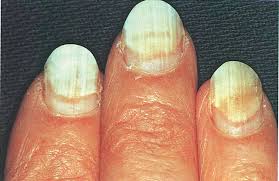In normal, healthy people, fungal infections of the nails are most commonly caused by fungus that is caught from moist, wet areas. Communal showers, such as those at a gym or swimming pools, are common sources. Going to nail salons that use inadequate sanitization of instruments (such as clippers, filers, and foot tubs) in addition to living with family members who have fungal nails are also risk factors. Athletes have been proven to be more susceptible to nail fungus. This is presumed to be due to the wearing of tight-fitting, sweaty shoes associated with repetitive trauma to the toenails. Having athlete's foot makes it more likely that the fungus will infect your toenails. Repetitive trauma also weakens the nail, which makes the nail more susceptible to fungal infection.
Elderly people and people with certain underlying disease states are also at higher risk. These include anything that impairs your immune system can make you prone to getting infected with the fungus. These include conditions such as AIDS, diabetes, cancer, psoriasis, or taking any



 Contact Us
Contact Us






 Hospitals
Hospitals
 Doctors
Doctors
 Diagnostic
Diagnostic
 Pharmacy
Pharmacy
 Health Tips
Health Tips
 Blog
Blog

























Comments